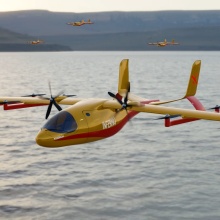Whether Spain, France, or the Elbe Sandstone Mountains: In the heatwave summer of 2022, large areas of forest are on fire. In many cases, fires are fought from the air using firefighting aircraft or helicopters, both of which have their advantages and disadvantages. A team from the Aerospace Engineering study program at the University of Stuttgart has now presented a concept for a hybrid firefighting aircraft that combines the advantages of both systems – and, with its design “Inferno”, the team won this year’s Design Challenge from the German Aerospace Center (DLR).
Firefighting aircrafts are filled up with water at an airport or at large lakes and take it quickly and efficiently over long distances to where the fire is. The disadvantage: Since the propellers are designed for forward flight, a lot of space is needed for takeoff and landing or for water intake (the so-called scooping), which limits the aircraft’s capabilities. Helicopter rotor blades, on the other hand, are horizontal and allow pilots to descend vertically over a small lake or even swimming pools to collect water. In addition, a helicopter can hover in the air and accurately drop extinguishing water over the source of the fire. This makes helicopters more flexible, but they are also slower and consume considerably more energy.
Combining speed and flexibility
In order to combine the speed and efficiency of a plane with the flexibility of a helicopter, the Stuttgart students Benjamin Knoblauch, Günay Can, Hannes Kahlo, Johannes Ritter, Nicolas Mandry, and Prishit Modi designed an aircraft for the competition that has two aircraft propellers for forward flight and eight propellers for vertical flight. This is possible due to the lightweight construction of the components made of fiber composites and, according to the jury, “a clever combination of technologies”. For example, “Inferno” has a hybrid-electric propulsion system comprising electric motors, a battery, and a gas turbine and can also be refueled in the air. “This significantly reduces fuel consumption and provides more time for firefighting,” the Stuttgart students say. Because airborne firefighting is a very challenging and often dangerous task for pilots, much attention was also paid to cockpit ergonomics and support systems when designing the aircraft.
Teamwork in the air
In operation, “Inferno” does not act alone, but as a team. The operational concept includes 4-6 identical aircraft with different payload modules: “Poseidon“, “Taru“, “Fons“, and “Aegir“ fight the fire with the extinguishing-water module. One or two additional aircraft for passengers and cargo ensure supply or the evacuation of people in distress as well as the establishment of a base station. “In this way, year-round utilization of the aircraft is possible also outside the wildfire season,” say the students.
The team was supervised by Prof. Andreas Strohmayer and Johannes Schneider from the Institute of Aircraft Design (IFB) at the University of Stuttgart. Strohmayer is pleased about the first place in the DLR Design Challenge 2022: “With ‘Inferno’, the students designed a realistic firefighting aircraft that has achieved excellent results in all the competition’s criteria. They were very committed and successfully applied what they had already learned, and acquired a lot of new knowledge and skills.”
Invitations to Stockholm and Dresden
The DLR Design Challenge is aimed at students at technical universities in Germany. In this year’s Challenge, the young aircraft designers from the University of Stuttgart competed against five other teams and won the competition. In September, they will have the opportunity to present their design to an international audience of aviation engineers at the ICAS conference (the Congress of the International Council of the Aeronautical Science) and at the German Aerospace Congress (DLRK) in Dresden.
Expert Contact:
Johannes Scheider, University of Stuttgart, Institute of Aircraft Design (IFB), Department of Aircraft Design Analysis, phone ++49 711 685-60483, E-Mail





